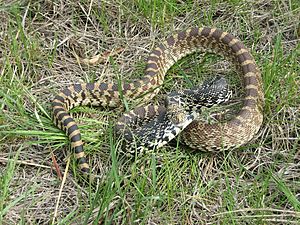Bullsnake facts for kids
Quick facts for kids Bullsnake |
|
|---|---|
 |
|
| Scientific classification |
|
| Kingdom: | Animalia |
| Phylum: | Chordata |
| Class: | Reptilia |
| Order: | Squamata |
| Suborder: | Serpentes |
| Family: | Colubridae |
| Genus: | Pituophis |
| Species: | |
| Subspecies: |
P. c. sayi
|
| Trinomial name | |
| Pituophis catenifer sayi (Schlegel, 1837)
|
|
| Synonyms | |
The bullsnake (Pituophis catenifer sayi) is a really big snake! It's not venomous, meaning it's not poisonous. It's actually a type of gopher snake. Bullsnakes are some of the longest snakes in North America and the United States. They can grow up to 8 feet long!
Contents
What's in a Name?
The name sayi comes from an American naturalist named Thomas Say. In Mexico, bullsnakes are called cincuate. This name comes from the Nahuatl language. It means "corn snake" because sentli means corn and coatl means snake.
Where Do Bullsnakes Live?
Bullsnakes live all over North America. You can find them in the United States, central and northern Mexico, and southern Canada. In Canada, they live in places like Saskatchewan, Alberta, and some desert areas of British Columbia.
What Do Bullsnakes Look Like?
Adult bullsnakes are usually about 4 to 6 feet long. Some have even been found to be over 8 feet long! They can weigh between 2 and 3 pounds, but some bigger ones can weigh up to 10 pounds. This makes them one of the largest snakes in Canada and the United States.
Bullsnakes are usually yellow with brown, white, black, or reddish spots. These spots are large on their backs. They have three sets of spots on their sides and black bands on their tails. Sometimes, you can find bullsnakes with different colors, like albinos (all white). It can be hard to tell baby bullsnakes apart from other gopher snakes just by looking at them.
What Do Bullsnakes Eat?
Bullsnakes are very strong constrictors. This means they squeeze their prey tightly. They eat small mammals like mice, moles, rats, pocket gophers, ground squirrels, and rabbits. They also eat ground-nesting birds, birds' eggs, and lizards.
They are good at climbing, so they can climb to bird nests to eat the baby birds or the mother bird. One bullsnake can eat five small birds in just 15 minutes! Young bullsnakes eat small lizards, frogs, and baby mice. Some people believe bullsnakes sometimes eat rattlesnakes. This is one reason why people are told not to hurt bullsnakes in the wild.
How Do Bullsnakes Behave?
Some bullsnakes can be calm and get used to being handled. But most of them are quite defensive. When a bullsnake sees something big that isn't food, it thinks it's a predator. Its first reaction is to stay still. If it can, it will try to move away very quickly.
However, bullsnakes are not very fast. So, if they can't escape, they will try other ways to defend themselves. When a bullsnake feels threatened by something as big as a human, it will rear up. It tries to look as big as possible. At the same time, it will hiss loudly at the threat. Then, it might lunge forward and pull back to try and get away.
Bullsnakes are sometimes mistaken for rattlesnakes. This can lead to them being killed. Bullsnakes look a bit like the western diamondback rattler. They use this similarity to scare away threats. When a bullsnake feels threatened, it will do an amazing rattlesnake impression!
First, it hisses very loudly. It pushes air out of its windpipe, making a sound like a rattle. It also makes its body into an "S" shape, like a rattlesnake ready to strike. It often shakes its tail very fast in leaves or brush. This makes a rattling sound. It also flattens its head to look like the triangular head of a rattlesnake. These actions are meant to scare away danger, not to attack. Unlike rattlesnakes, which usually lift their tails to rattle, bullsnakes often keep their tails on the ground. They shake them against leaves to make noise.
How Do Bullsnakes Reproduce?
Bullsnakes usually breed in March or April. They lay their eggs in April, May, or June. They typically lay about 12 eggs in sand or other safe places. They leave the eggs to hatch on their own. Sometimes, they lay as few as 5 eggs or as many as 22.
The eggs are oval-shaped, leathery, and sticky. They can be up to 2.75 inches long. The eggs usually hatch in August or September. Baby bullsnakes are about 8 to 18 inches long when they hatch. Their color is grayish until they shed their skin for the first time.



